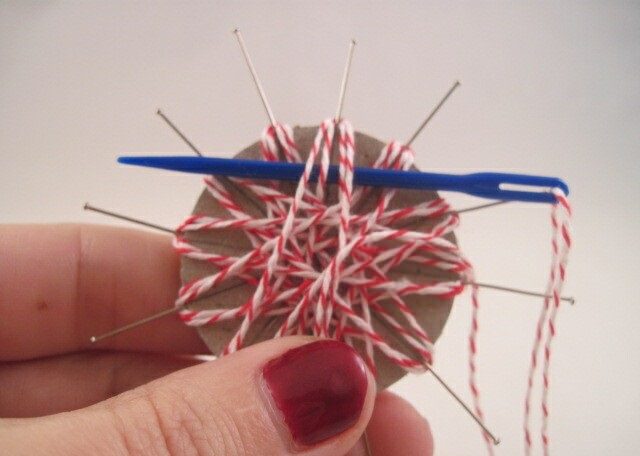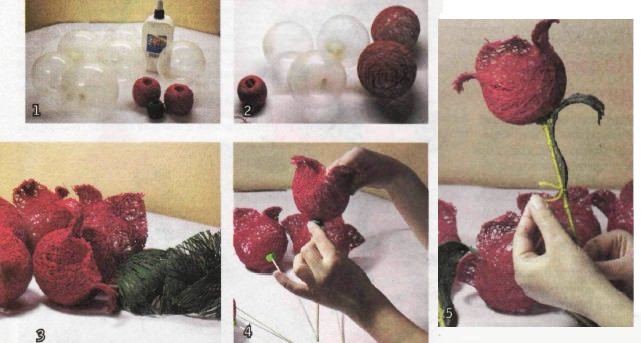
Flowers from the threads themselves: step by step master classes (photo)
Content
- Materials for making flowers
- Working with threads
- Video: master class on knitting flowers
- Video: weaving a flower from threads on a special machine
- Using wire for weaving flowers
- Video: plait flowers from threads with their own hands
Crafts made by own hand, thisAlways stylish. The most popular decoration is of course flowers. For their manufacture use a wide variety of materials and devices. The variety of flower forms in nature makes it possible with great success to use for the creation of crafts in the form of artificial flowers as a variety of colors, and all sorts of materials.
Flowers can be either complex or simple in nature.Form, have a large number of different in size petals or be simple enough to make, composed of several identical elements. Then they can be done with their children, which will undoubtedly bring joy and pleasure to both. In order to facilitate the creation process as much as possible and be able to create petals and flowers of any shape, it is better to use soft materials.





Materials for making flowers
The most commonly used materials for creating flowers are:
- the cloth;
- Tapes;
- thread;
- beads;
- wire;
- paper.
To this, you can also add glue or glue gun, scissors, pliers, nippers, molds, tweezers, a lighter or a candle.
Selecting materials If you want to make flowers fromBeads, these products are made with their own hands rather troublesome, but the result is quite refined, it will be appreciated by every master. The peculiarity of such crafts will be its relatively large weight and the need to select the thickness of wire, line or thread to the size of the beads. A large number of small parts make this work difficult, and not everyone can do it with their own hands.

If we are talking about how to weave flowers from ribbons,Preference is given to the atlas, because they always look colorful. When working with tapes, it is necessary to use a quick-drying thick glue, optimally - an adhesive gun. Flowers from tapes are often made on the basis. Fabric, cardboard or wire can serve as a basis. There is a class of colors created from tapes, either without a foundation at all, or on a stem. Most often these are roses, carnations and orchids, but each of them can be created in this way. Tapes very easily take the necessary shape during the processing by fire. Such flowers require a fairly accurate handling and reliable, but gentle fixation.
In order to create flowers from threads, useful:
- Shape for weaving;
- Multicolored thread;
- Needle with thread or harness for fastening;
- scissors;
- wire.
Also, different hardware may be useful, depending on what kind of result you need to get.
Working with threads
Can
Of the threads crocheted. With this method of creating their own hands, the master can make fluffy flowers, flat or tie the finished base. Knit crochet can be thread of very different quality, while their pre-winding is not needed. If the flowers are connected by a complex technical pattern from the bunched thread - this is a high class and an excellent result. Such crafts are very attractive and original.
Video: master class on knitting flowers
If you want to weave a flower with your own hands, you need to prepare the thread.
On a special device or made of wire form it is better to apply smooth threads, not boucleed and without any adornments. With such a thread it is much easier to work with.
Wrapped flowers Make flowers from threads is not difficult, the main thing is to understand the sequence of the process and that everything you need is at hand.
If the thread is too slippery, you need itCareful fixing both during winding on the mold, and during the sewing of the petals and giving the product the final shape. If the thread slips badly, it clings to the edges of the mold, it scrapes the hands, it is better not to use it or pass through the wax. The edges of the form must also be smooth, so as not to cling and not to split the thread.

A variety of materials can be used as a form.
Cardboard can be the simplest. Two identical rectangles of cardboard are added together. Between them is passed a separate thread or a piece of wire - it will serve as the basis for the center. On both rectangles, the same uniform thread rings are wound together. To get a quality craft, you will have to try and show a high class. The edges of the form should be smooth, and the thread moderately sliding. Here you have to choose everything yourself: with what threads it is better to work, to process them or not, how to round the edges of the form. Perhaps someone has already worked with similar materials and will share their results, but the number of threads is so diverse that it is difficult to hope for such a thing. After the required number of turns is wound, carefully pull out the cardboard and pull off the fixation thread. We get a beautiful flower, but it will look like a ball.
To obtain a flat product, each lobe must be individually fixed. All of them need to be weaved in one plane. To this end, use special devices.
Device for creating colors from threadsIs a plastic circle with legs. On the legs, the strings are wound in a sequential order from one leg to the opposite through the center. The result is a plump flower core and evenly spaced petals. The number of wound circles determines the splendor of each petal. You can create two-layer flowers when the core has a smaller size of the petals. When creating this decoration, it is convenient that the fastening of the petals is carried out by a separate thread, so the flower on the form can be decorated with colored threads, ribbons and even beads. The attached flower can be removed freely from the mold.
If there is no ready factory installation to createFlowers by their own hands, not even a great master can make it. It's easiest to use a cardboard circle with cuts for threads. On such a circle the thread is wound by a continuous spiral. Therefore, you should use 2 circles of cardboard with a fairly wide center. Between the circles you can skip a piece of wire or thread - this is the future basis. In the center you can form a middle and beautifully arrange it. With this winding, after the formation of the flower, the cardboard forms must be cut to pull them out of the center.














A better option is to serveCardboard circle with markings. By marking it is necessary to attach to it pieces of wire. Then the flower is easier and faster to weave by clinging the thread behind the wire guides.
Video: weaving a flower from threads on a special machine
Using wire for weaving flowers

A huge minus of almost all colors,Executed by their own hands, is their softness, inability to keep their form. This does not apply to flowers made from hard materials, but it is very important for colors of beads, ribbons, fabrics, threads. If, when creating colors from beads, they can have some stiffness due to the tight tension of the line and the rigidity of the bead itself, then tapes and other soft material need a basis. An excellent solution to this issue is the use of wire.
You can use ready-made wire formsTo create flowers, or create them yourself. In order to wind the threads on the mold, you need to fix them on each circle. To achieve such a fixation on a slippery wire is impossible, therefore, contours are used in the form of a spiral. The contours of the flower are wound around the threads.
Advantages of spiral wire circuits:
- The shape plays slightly, which makes the flower more alive;
- Stitches lie exactly and at equal distances from each other;
- You can create details of crafts of different thicknesses;
- Do not use additional fixation of threads and the finished colors themselves;
- Long form tips are combined into a common trunk for the finished composition.
Multiple layers of threads create volume on the sameForm of wire, where one layer forms a leaf tonic or petals. It is also possible to wind the threads in several layers at different angles, reaching extraordinary patterns and geometric figures on the leaves or petals of the craft. The greater the distance between the turns on the wire, the thicker the thread is needed. In this case, the filling of the space of the shape with filaments can be carried out both by parallel stitches, and diverging from a certain point, more often from the center.










Also, thread colors can be created in technologyMacrame, winding on the fingers or bar, a simple set of loops of the type of knitting and many other ways. All of them allow you to get an excellent result and fully enjoy the process of creativity.
Video: plait flowers from threads with their own hands




